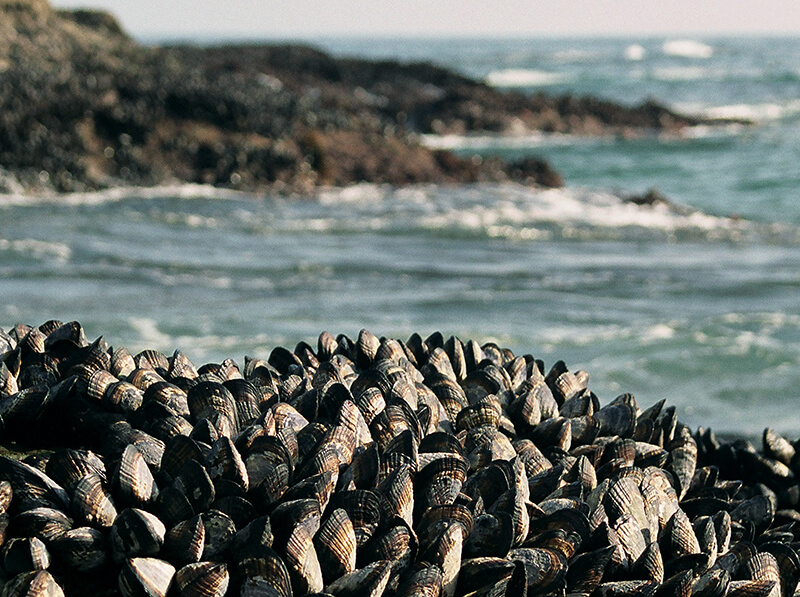July 29, 2020
Changing seawater hints at future for adhesives from sea creatures

A Purdue University innovator who studies ocean creatures to develop adhesives is now turning his team’s attention to the changing chemistry of seawater to gain insights to design adhesives for consumer products. (Image provided)
WEST LAFAYETTE, Ind. – A Purdue University innovator who studies ocean creatures to develop adhesives is now turning his team’s attention to the changing chemistry of seawater – to see how it may affect the ability of animals to stick – and then use these insights to design adhesives for consumer products.
Jonathan Wilker, a Purdue professor of chemistry and materials engineering, has spent years studying how marine mussels secrete sticky plaques for attaching themselves to wet surfaces. His research group uses these discoveries to create new, biomimetic adhesives for everything from electronics and vehicles to construction structures and cosmetics.
Wilker details his team’s findings in the latest edition of the journal Environmental Science & Technology. The National Science Foundation and the Office of Naval Research provided support for this work.
Wilker said the mussels’ adhesive is rich in iron, which is thought to help make the attachments strong and flexible. So, his team set out to test what happens when the animals are surrounded by different concentrations of iron.
“We wanted to understand how mussels’ access to environmental iron might influence the formation and performance of their adhesive system,” Wilker said.
The researchers grew animals in waters with low, regular and excess iron.
"We found that there was a general trend in which the strength of the mussels' adhesive tracked with iron levels in the surrounding seawater," Wilker said. “When there was less iron, the glue was weaker. More iron than normal brought about the strongest bonding. At an extreme excess of iron, however, performance dropped.”
Beyond understanding how animals make materials, there is a link for this work to ongoing climate change.
"Most iron in seawater is particulate, in solid forms. Mussels are filter feeders and they collect their food, as well as this iron, by filtering the water," Wilker said. “As the oceans become more acidic, iron transitions from solid to more dissolved forms. In the years to come, if less iron is in solid forms, these filter feeders will have difficulty capturing the iron that they need for making their adhesive. Seeing a fairly direct correlation between seawater iron content and mussel adhesive performance provides us with ideas for designing new and robust synthetic materials.”
Wilker works with the Purdue Research Foundation Office of Technology Commercialization to patent his innovations. For more information on licensing a Purdue innovation, contact the Office of Technology Commercialization at otcip@prf.org.
About Purdue Research Foundation Office of Technology Commercialization
The Purdue Research Foundation Office of Technology Commercialization operates one of the most comprehensive technology transfer programs among leading research universities in the U.S. Services provided by this office support the economic development initiatives of Purdue University and benefit the university's academic activities through commercializing, licensing and protecting Purdue intellectual property. The office recently moved into the Convergence Center for Innovation and Collaboration in Discovery Park District, adjacent to the Purdue campus. In fiscal year 2020, the office reported 148 deals finalized with 225 technologies signed, 408 disclosures received and 180 issued U.S. patents. The office is managed by the Purdue Research Foundation, which received the 2019 Innovation and Economic Prosperity Universities Award for Place from the Association of Public and Land-grant Universities. In 2020, IPWatchdog Institute ranked Purdue third nationally in startup creation and in the top 20 for patents. The Purdue Research Foundation is a private, nonprofit foundation created to advance the mission of Purdue University. Contact otcip@prf.org for more information.
About Purdue University
Purdue University is a top public research institution developing practical solutions to today’s toughest challenges. Ranked the No. 6 Most Innovative University in the United States by U.S. News & World Report, Purdue delivers world-changing research and out-of-this-world discovery. Committed to hands-on and online, real-world learning, Purdue offers a transformative education to all. Committed to affordability and accessibility, Purdue has frozen tuition and most fees at 2012-13 levels, enabling more students than ever to graduate debt-free. See how Purdue never stops in the persistent pursuit of the next giant leap at purdue.edu.
Writer: Chris Adam, 765-588-3341, cladam@prf.org
Source: Jonathan Wilker, wilker@purdue.edu
ABSTRACT
Availability of Environmental Iron Influences the Performance of Biological Adhesives Produced by Blue Mussels
Natalie A. Hamada, Christopher Gilpin and Jonathan J. Wilker
Animals incorporate metals within the materials they manufacture, such as protective armor and teeth. Iron is an element used for adding strength and self-healing properties to load bearing materials. Incorporation of iron is found beyond hard, brittle materials, even being within the soft adhesive produced by marine mussels. Such findings suggest that the bioavailability of iron may have an influence on the properties of a biological material. Experiments were conducted using live mussels in which seawater iron levels were deficient, normal, or in excess of typical concentrations. The weakest adhesive strengths were produced in iron deficient waters.
Increasing seawater iron brought about more robust bonding. Changes in strengths correlated with varied adhesive morphology, color, and microstructural features, likely a result of variations in the degree of iron-induced protein cross-linking. This study provides the first whole animal scale data on how manipulations of bioavailable iron influence the performance of a biological material. Changing ocean chemistries will alter iron bioavailability when decreasing pH shifts elemental speciation from particulate to dissolved, hindering the ability of filtering organisms to capture nutrients. These results show future implications of changing ocean chemistry as well as the resulting abilities of marine organisms to construct essential materials.

